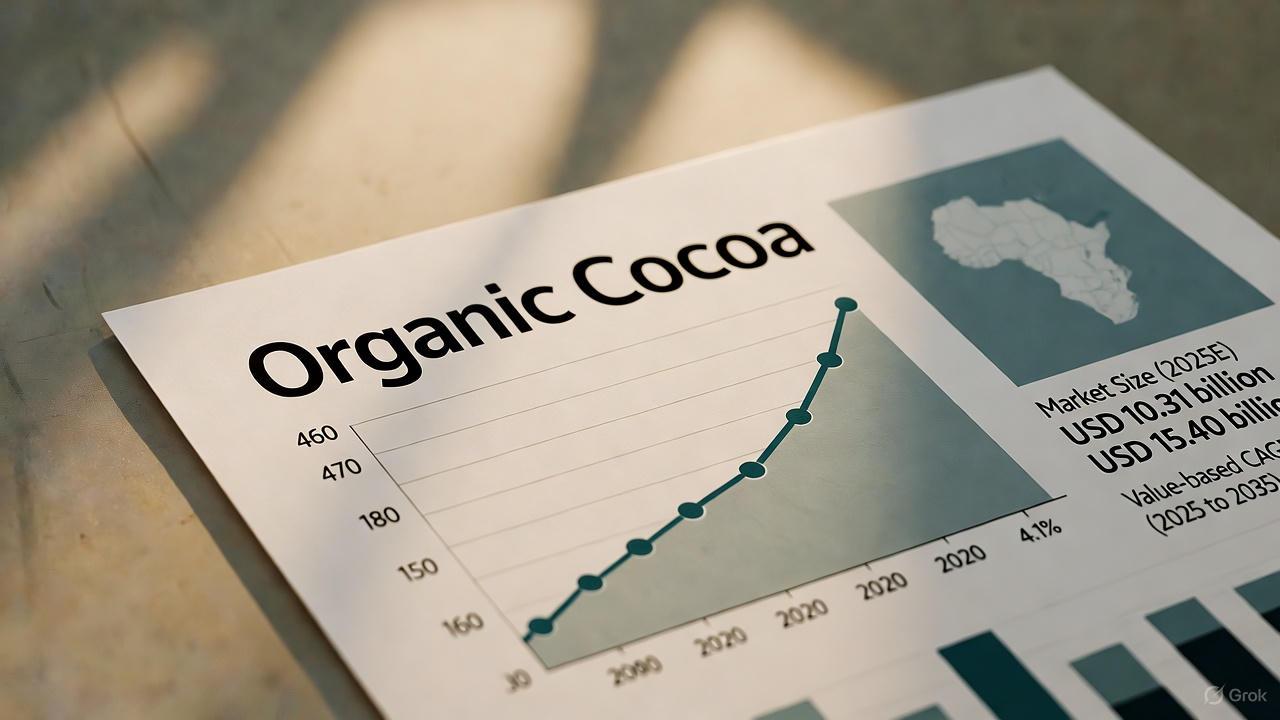Organic Cocoa Market to Hit USD 15.4 Billion by 2035

The global organic cocoa market is projected to expand from USD 10.31 billion in 2025 to USD 15.40 billion by 2035, registering a CAGR of 4.1%. This growth is largely propelled by rising consumer awareness of ethical sourcing, sustainability, and health benefits. The “organic” label today signifies not only quality but also environmental responsibility and fair trade, which are fast becoming key purchasing drivers for modern consumers.
Organic certification standards, such as USDA Organic, EU Organic, and India Organic, have emerged as trust symbols across global markets. For established chocolate manufacturers and new entrants alike, these certifications are no longer optional but essential. They validate authenticity, ensure adherence to strict farming protocols, and bolster consumer confidence. As organic cocoa represents only about 0.5% of the total global cocoa production, certified producers gain a competitive edge in a niche yet expanding segment.
Get this Report at $3500 Only (Report price) | Exclusive Discount Inside!: https://www.futuremarketinsights.com/reports/sample/rep-gb-1058
Expanding Global Presence: Key Regional Markets
The European Union continues to dominate the organic cocoa trade, with Germany and the Netherlands serving as major processing hubs. Demand for organic and fair-trade chocolate products is surging as consumers prioritize sustainability and quality. The United States follows closely, fueled by the rising popularity of premium confectionery, health-conscious snacking, and clean-label beverages. Japan, though smaller in volume, is seeing accelerated growth as its consumers lean toward artisanal chocolate and plant-based innovation.
In emerging markets such as India and Thailand, rapid urbanization and awareness of organic lifestyles are creating new opportunities for both established brands and smaller producers. India’s organic cocoa market is anticipated to grow at a CAGR of 6.8%, driven by a growing preference for sustainable products among millennials and Gen Z consumers.
Driving Forces Behind the Market Growth
Health awareness is a major growth factor, as organic cocoa is rich in antioxidants and free from pesticides. Environmental concerns are equally significant, with the European Union’s Deforestation-Free Regulation encouraging sustainable sourcing practices. Ethical consumers are increasingly favoring cocoa that is traceable, fair-trade certified, and environmentally responsible.
Corporate commitments are shaping the future of the market as leading producers adopt sustainability programs and transparency in their supply chains. These initiatives not only enhance brand reputation but also secure long-term supply stability and market differentiation. As more manufacturers shift toward sustainable sourcing, the organic cocoa industry is expected to witness stronger global integration and consumer loyalty.
Industry Challenges: Balancing Supply, Cost, and Certification
Despite its growth potential, the organic cocoa industry faces significant hurdles. Limited supply remains the primary challenge, as less than 1% of global cocoa is produced organically. Stringent certification requirements and the labor-intensive nature of organic farming make it difficult for smallholders to transition from conventional practices. High production costs, combined with certification fees and volatile cocoa prices, often limit scalability and profitability.
Maintaining product integrity through complex supply chains adds another layer of challenge. From specialized transport to contamination-free processing, companies must invest in infrastructure to preserve certification standards. These operational challenges underscore the importance of technology-driven traceability systems and cooperative farming models that empower small producers.
Market Segmentation and Emerging Trends
Cocoa powder remains the most dominant product form, expected to hold 35% market share in 2025 due to its versatility in bakery, confectionery, and beverage applications. The bakery and confectionery segment continues to lead with a 36% market share, as demand for dark chocolate and organic desserts accelerates globally. Meanwhile, cocoa butter is gaining traction in skincare and cosmetics, while cocoa liquor benefits from the premiumization trend in gourmet chocolates.
- Art
- Causes
- Crafts
- Dance
- Drinks
- Film
- Fitness
- Food
- Juegos
- Gardening
- Health
- Inicio
- Literature
- Music
- Networking
- Otro
- Party
- Religion
- Shopping
- Sports
- Theater
- Wellness


